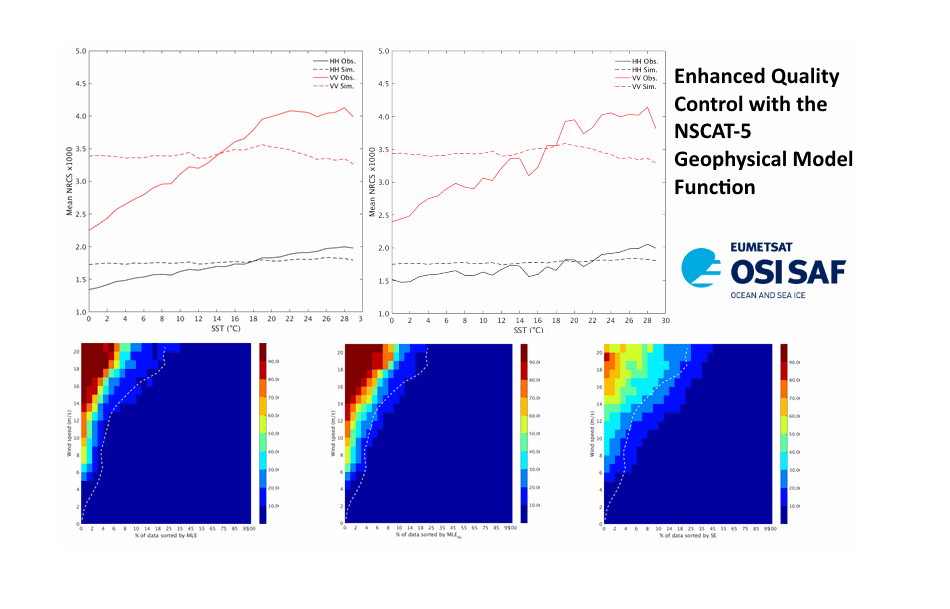03/05/2019
Enhanced Quality Control with the NSCAT-5 Geophysical Model Function
-
In the context of the OSI SAF Visiting Scientist Program, Wenming Lin from the Institut de Ciències del Mar (ICM - CSIC) in Barcelona, Spain (now with the Nanjing University of Information, Science, and Technology, China), worked on the validation of the new Geophysical Model Function and on the improvement of the quality control for Ku-band rotating pencil-beam scatterometers. This work took place in 2017 - 2019 and was supervised by Marcos Portabella (ICM) and Ad Stoffelen (KNMI).
Objectives and framework of the study:
Recent developments on the wind geophysical model function (GMF) of Ku-band scatterometers include a sea surface temperature (SST) dependent term. It has been found that the SST effects on the radar backscatter are wind speed dependent and more pronounced in vertical polarization (VV) than in horizontal polarisation (HH) at higher incidence angles, and are relevant at Ku-band radar wavelengths. A recent CDOP-2 AS study (OSI_AVS_17_01) confirms that the NSCAT-5 GMF is applicable for both the USA RapidScat and the Indian SCATSat-1 backscatter measurements. The separate SST effects on VV and HH reduce the wind retrieval residuals and therefore may affect the quality control (QC).
The goal of this study is to further consolidate the NSCAT-5 GMF by looking for QC dependencies. An improved QC method, based on the successful experience with previous Ku-band rotating pencil-beam scatterometers, is developed for SCATSat-1 data using collocated ASCAT-derived winds and GMI rain rate data as reference.
Report conclusions:
The top plots show the mean observed (solid) and simulated (dashed) radar backscatter (value times 1000) as a function of SST for wind speed of 5.5 m/s<V<6 m/s. The black curves are for HH polarisation and the red curves for VV polarisation. The observed backscatter values (σ0) correspond to two different QC filtering procedures: REF-QC (left) and KNMI-QC (right). Note that the latter contains substantially more high wind variability conditions and/or presence of rain than the former. It is found though that the developed GMF is not particularly sensitive to different QC thresholds, although the stricter QC (REF-QC) leads to more regular backscatter sensitivities and appears thus beneficial for the derivation of geophysical dependencies.
Three different Scatsat-1 derived parameters, two based on the wind inversion residual (MLE and MLEm) and one based on an image processing technique called singularity analysis (SE), are tested as QC indicators. The bottom plots show the percentage of rain-contaminated data (GMI RR > 1 mm/h, see colour legend) as a function of SCATSat-1 wind speed and the sorted percentiles by three different QC indicators (left): MLE, (middle) MLEm, and (right) SE, where the first two are based on the inversion residual and the third on an image processing technique (singularity analysis). It is found that for the inner swath, MLE(m) is a more effective rain indicator. SE is however a more effective indicator of discrepancies between collocated SCATSat-1 and ASCAT winds. Further investigation is required to conclude whether collocation errors in areas of high wind variability are the main cause of such discrepancies or not. A combination of the three mentioned indicators should lead to an optimized QC.
Benefits for the SAF:
-
Synergetic application of multiple EUMETSAT satellite products, notably OSI SAF wind data from different scatterometers (KNMI);
-
Interaction with the International Ocean Vector Winds Science Team on the OSI SAF plan and results of the AS and interaction with the international scientific community;
-
Further development of the NSCAT-5 GMF;
-
Improved quality control of wind products from Ku-band scatterometers; particularly for ScatSat.
Report on this study : Enhanced Quality Control with the NSCAT-5 Geophysical Model Function
-

